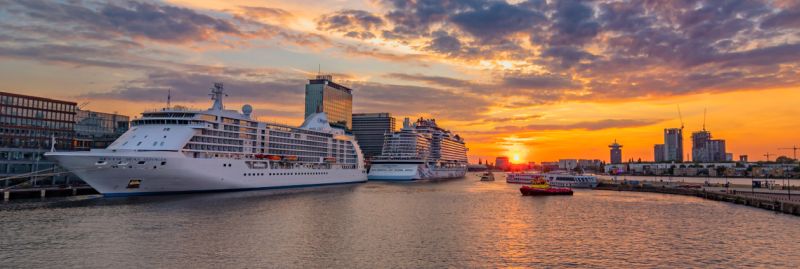 Have cruise ships worn out their welcome? Increasingly, port cities around the world are banning or regulating cruise ship dockings and operations in their coastal waters. Amsterdam has become only the most recent to do so.
Have cruise ships worn out their welcome? Increasingly, port cities around the world are banning or regulating cruise ship dockings and operations in their coastal waters. Amsterdam has become only the most recent to do so.
The BBC reports that Amsterdam’s council has banned cruise ships from the city center as the Dutch capital tries to limit visitor numbers and curb pollution.
Politicians said the vessels were not in line with the city’s sustainable ambitions.
It means the central cruise terminal on the River IJ near Amsterdam’s main train station will close. It is the latest measure to clamp down on mass tourism in the city.
Cruise ships have become a symbol of the problem, with more than 100 mooring in the capital every year. The region has another port about 18 miles east in IJmuiden that will not be impacted by the ban.
Amsterdam is by no means the only port banning or restricting large cruise ships.
Barcelona
In June, the regional government of Catalonia said it would soon introduce measures intended to limit liners arriving at the port of Barcelona, which had been Europe’s busiest cruise terminal before the pandemic.
Venice
In 2021, Italy banned cruise liners above 25,000 GT from Venice’s lagoon. Specifically, these large ships are banned from the shallow Giudecca Canal that leads past Piazza San Marco, the city’s most famous landmark.
Dublin
Brexit was the reason cited for a limit to cruise liner traffic starting in 2019 at Dublin Port. At the time, 160 cruise ships’ calls were already booked for 2019, with 140 bookings set for 2020, the Irish Times reported, and in 2021 the number of allowed cruises was cut to 80. Officials said port capacity was needed for increased container traffic after the U.K. left the European Union.
Santorini
Santorini started limiting the number of cruise ship passengers allowed per day to 8,000 in 2019. Santorini also saw spikes in air pollution in 2018, according to The Independent, which the Hellenic Ornithological Society blamed on the cruise ship industry’s use of heavy fuel oil.
French Polynesia
It’s been 18 months since the government of French Polynesia banned cruise ships carrying more than 3,500 passengers at any of the country’s ports, including at the popular destination Bora Bora. Tahiti now only welcomes ships with fewer than 2,500 passengers and those with more than 1,200 can’t dock at all in Bora Bora, according to Conde Nast Traveler.
Norway
The Norwegian government made a decision to put a ban on any cruise ship that would pollute the fjord waters in all the fjords on the UNESCO World Heritage Site called The West Norwegian Fjords last year. From 2026 and onwards, only zero-emission cruise ships can enter the UNESCO-designated fjords.
Currently, no zero-emission cruise ships operate in Norwegian waters. Last June, Norwegian ferry and expedition cruise operator Hurtigruten revealed plans for a zero-emissions electric cruise ship with retractable sails fitted with solar panels, that will sail the Norwegian coast by 2030.
Thanks to Alaric Bond for contributing to this post.

Collapsing under their own weight (displacement)? Perhaps if cruise lines had stuck with more modest ambitions they’d still be welcome. 6,000 passengers here, 6,000 passengers there and pretty soon we’re talking “roll up the welcome mat.”
We are the human equivalent of Locusts swarming.